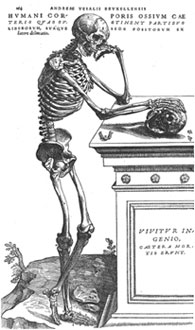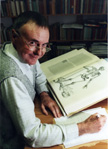Publications Anatomy: Vesalius’s On the Fabric of the Human Body

 WEIGHTY WORK: Translating a 5.5kg 16th-century Latin text has been a pain, but a worthwhile one, says Dr. William Richardson, who is still only halfway through the task. Photo courtesy of the New Zealand Herald.
WEIGHTY WORK: Translating a 5.5kg 16th-century Latin text has been a pain, but a worthwhile one, says Dr. William Richardson, who is still only halfway through the task. Photo courtesy of the New Zealand Herald.
Classic Labour Proves Heavy Going
by Keith Perry
June 30, 1998. Courtesy of The New Zealand Herald.
It is a heavyweight book by any standard. But the 16th-century Latin medical textbook which university lecturer Dr. William Richardson has spent five years translating has taxed more than his brain. Lifting the weighty 5.5kg, seven-volume tome every day has given the classics and ancient history expert shoulder strain. He now needs regular treatment from a physiotherapist and sessions at a gym paid for by the University of Auckland. But doctors worldwide would say 59-year-old Dr. Richardson’s muscle fatigue is a small price to pay for his contribution to medical research. He is producing the world’s first complete translation of the most important anatomy guide ever published, De Humani Corporis Fabrica Libri Septem (On the Fabric of the Human Body). And as fewer and fewer doctors speak Latin, his work will prevent the 400,000-word manuscript being consigned to dusty archives forever. Assisted by the Emeritus Professor of Anatomy at the Auickland Medical School, John Carman, Dr. Richardson spends every minute of his spare time poring over the ancient script and woodcut illustrations to discover what was known about dissection in 1543. “Initially, all medical students were taught Latin and would have been able to understand the work in its original form,” he said. “The book is still a fixture in medical libraries around the world. But the decline of Latin as the main language used in medicine would have spelled doom for it as a working textbook, as no one in modern medicine would have been able to read it. As it is probably the most important anatomy book ever written, I felt I had to preserve its use for medical science and decided to translate the entire manuscript. It has been the most important achievement of my scholastic life.”
Five years later, his bookmark only divides the original volume in half. Dr. Richardson says he translates about one page a day of the technical Renaissance Latin before passing the draft to Professor Carman, who checks for anatomical accuracy. He has also found his daughter Diana, a doctor, a pillar of support in checking his medical facts. The work has been physically challenging, as the original is far too heavy to take to bed or read comfortably on a table. Dr. Richardson built a slanted stand to support the book, but still needs the regular massages and gym workouts to sustain the strain on his upper body.
But as Vesalius’s Fabrica was a cornerstone of the Renaissance scientific revolution, which changed the study of anatomy forever, Dr. Richardson believes this particular pain in the neck was well worth suffering.
« back to all Anatomy Publications
back to top
